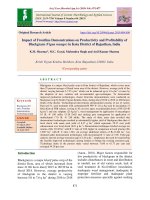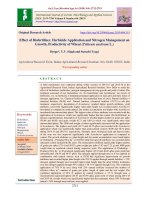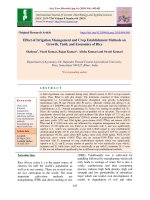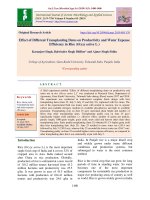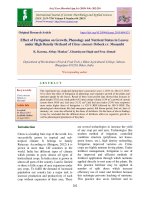Effect of fertigation on productivity and economics of dwarf coconut cv. Chowghat orange dwarf (COD)
Bạn đang xem bản rút gọn của tài liệu. Xem và tải ngay bản đầy đủ của tài liệu tại đây (282.27 KB, 6 trang )
Int.J.Curr.Microbiol.App.Sci (2019) 8(5): 1163-1168
International Journal of Current Microbiology and Applied Sciences
ISSN: 2319-7706 Volume 8 Number 05 (2019)
Journal homepage:
Original Research Article
/>
Effect of Fertigation on Productivity and Economics of Dwarf Coconut cv.
Chowghat Orange Dwarf (COD)
S. Rani1*, C. Sudhalakshmi1, K. Venkatesan1 and H.P. Maheshwarappa2
1
Coconut Research Station, Aliyarnagar – 642 104 (Tamil Nadu), India
2
ICAR-CPCRI, Kasaragod – 671 124 (Kerala), India
*Corresponding author
ABSTRACT
Keywords
Fertigation, Tender
nut yield,
Economics
Article Info
Accepted:
12 April 2019
Available Online:
10 May 2019
An experiment was conducted to study the effect of water soluble on dwarf coconut at
Coconut Research Station, Aliyarnagar. Application of 25, 50, 75, 100 and 125% of
recommended NPK through drip irrigation system was compared with the soil application
of recommended NPK as well as control with no fertilizer application. Application of
125% NPK through drip irrigation resulted in significantly higher Annual leaf production,
Number of functional leaves, number of inflorescence and tender nut yield per palm
compared to the control and the other fertigation treatments, except 100% NPK through
drip irrigation. Higher nutrient availability in split application of fertilizer through
fertigation favours increased nutrient uptake resulting in higher nutrient content in coconut
leaves. With respect to economics, gross return (Rs. 302400/ha) and net return
(Rs.153400/ha) were significantly higher with the application of drip fertigation of 125 per
cent RDF through WSF and it found to be on par with drip fertigation of 100 per cent RDF
through WSF. The drip fertigation levels 75% of RDF through WSF were found to be on
par with 100 % RDF through conventional fertilizers application method i.e through soil
application. The study indicated the possibility of saving 25% of the recommended
fertilizers by adopting fertigation which ensures higher productivity in coconut than soil
application.
Introduction
Coconut is grown in more than 93 countries
of the world in an area of 12.29 million ha
with a total production in terms of copra
equivalent of 11.04 million MT. Indonesia
(25.63%), Philippines (23.91%), India
(19.20%) are the major coconut producing
countries of the world. India occupies a
predominant position in respect of production
of coconut in the world. Tamil Nadu
produced 6570 million nuts in an area of
461060 ha, with productivity of 14251 nuts
per hectare as per CDB statistics in 2016-17.
There is a lot of scope for increasing
productivity of coconut with better
management in the state and thus improving
the rural economy. India has one of the largest
irrigated areas in the world, but its per-capita
as well per-hectare availability of water is one
1163
Int.J.Curr.Microbiol.App.Sci (2019) 8(5): 1163-1168
of the lowest in the world. The efficient and
judicious use of both water and fertilizer is
the key for improving agricultural production
and productivity in the country. Fertigation
(application of water-soluble solid or liquid
fertilizer through drip irrigation system) is an
attractive method of fertilization in intensive
agricultural systems. The drip method of
irrigation also helps in reducing overexploitation of groundwater that partly occurs
in surface irrigation. Water saving through
drip irrigation system is estimated to be in the
range of 12-84 per cent in different crops,
besides its beneficial impact on crop yields
(Narayanamoorthy,
1997).
The
drip
fertigation method has considerable potential
to improve water and fertilizer use efficiency.
In perennial crops like coconut drip
fertigation helps in achieving increased wateruse efficiency, decreased tillage requirement,
higher quality products, increased crop yields
and higher fertilizer-use efficiency besides
saving in water (Sivanappan, 2002 and
Namara et al., 2005). With the advent of this
new method of irrigation system, traditional
method of fertilizer application which is still
in practice by the farmers is being slowly
replaced by fertigation. Under fertilizer
management, fertigation is one of the
improved and efficient methods of fertilizer
application through which nutrients applied
directly to root zone of the plants. By this
practice fertilizer may be applied in number
of split doses which increase efficiency use of
water and fertilizer because this technique
prevents leaching of nutrients (Karuna et al,
2019). The annual nutrient export by various
parts of the palm viz., nuts, fronds, trunk,
bunch and spathe reported by different
workers vary from 20 to 174 kg N, 2.5 to 20
kg P and 35 to 249 kg K ha-1 (Pillai and
Davis, 1963). Considering the manurial value
of the coconut wastes it would be better to
incorporate these wastes in situ if properly
shredded. However, scarce research data is
available on the performance of dwarf
coconut palms under drip fertigation with
water soluble fertilizers as source of fertilizers
and shredded coconut waste as organic
manure. Keeping the above facts in view the
present experiment was laid out to study the
effect of fertigation on growth and yield of
dwarf coconut.
Materials and Methods
Field experiment was conducted for three
consecutive years from during 2015-16,
2016-17, and 2017-18 at Coconut Research
Station, TNAU, Aliyarnagar The research
station is situated at 10.49° N latitude and 77°
E longitude with an altitude of 20 m above the
mean sea level. The soil was sandy loam,
non-calcarious, non-saline and neutral in pH.
The experiment on intercropping of flower
crops in coconut garden was laid out in RBD
with three replications. The experiment
consisted of eight different levels of water
soluble fertilizer was given as treatments
viz.,: T1 - Control, T2 -25 % of RDF through
WSF, T3 -50 % of RDF through WSF, T4 -75
% of RDF through WSF, T5 -100 % of RDF
through WSF, T6 -125 % of RDF through
WSF, T7 -100 % RDF through conventional
fertilizers and T8 - farmers’ practice (20kg
FYM + 1Kg urea + 1Kg MOP). Fertigation
were given 15 years old COD (Chowghat
Orange dwarf) garden planted at a spacing of
7.5 m x 7.5 m. The fertilizers were applied
through drip fertigation in 12 splits at monthly
intervals with Urea, Diammonium phosphate
and Muriate of Potash as sources of nitrogen,
phosphorus and potassium respectively.
Benefit Cost ratio was computed as the
present value of benefits divided by the
present value of costs by using the following
formula
1164
Benefit t
t
1 r
t 1
t T
Cost t
t
1 r
t 1
t T
BCR
Int.J.Curr.Microbiol.App.Sci (2019) 8(5): 1163-1168
where Bt is the benefit in time t and Ct is the
cost in time t, r is the discount rate.
Statistical analysis
The experimental data were subjected to
statistical analysis in order to find out which
of the treatments showed significant variation
in different parameters studied under
investigation. The technique of analysis of
variance (ANOVA) for randomized block
design (RBD) was adopted as suggested by
Panse and Sukhatme (1967).
Results and Discussion
Effect of fertigation on growth and yield of
dwarf coconut
The results obtained by the effect of various
level fertigation treatments growth and yield
were carefully recorded and depicted in Table
1 and Table 2. Annual leaf production,
Number of functional leaves and number of
inflorescence did not influenced by different
fertigation levels at both the 2015-16 and
2016-17. Though the above growth attributes
were found to be statistically significant
during 2017-18, the variation was found to be
minimal. Number of functional leaves (30) and
number of inflorescence were higher in drip
fertigation of 125 per cent RDF through WSF
(T6) were found to be on par with drip
fertigation of 100 per cent RDF through WSF
(T5).
Significantly lowest number of inflorescence
(8.5) recorded in control treatment (T1).
Higher dose of fertilizer through fertigation
helped the plants for better uptake of nutrients
and consequently the good growth of plant.
These results are in confirmation with
Honnappa et al., (2017) in fenugreek. These
data also supported by the findings of Ramana
et al., (2014) who found maximum plant
growth when higher NPK dose were supplied
in the sweet orange
Highest nut yield (135.6 nuts/palm/year in
2016-17 and 138.4 nuts/palm/year in 201718) recorded in drip fertigation of 125 per
cent RDF through WSF (T6 treatment) and it
found to be on par with drip fertigation of 100
per cent RDF through WSF (T5 treatment).
Drip fertigation of 75 per cent RDF through
WSF (T4) were found to be on par with 100
per cent RDF through soil application (T7).
The per cent increase over the pre-treatment
nut yield was more (16.26 per cent) with drip
fertigation of 125 per cent RDF through WSF
(T6) followed by drip fertigation of 100 per
cent RDF through WSF (T5). The treatment
without fertilizer application (T1) (-11.93 per
cent) and drip fertigation of 100 per cent RDF
through WSF (T2) (-2.79 per cent) recorded a
negative increase over the pre-treatment nut
yield.
Economics of fertigation in tender coconut
Three years of mean data related to
economics of different levels of fertigation
have been analyzed and presented in Table 3.
Gross return worked out based on the mean
nut yield of three years and market price of
tender nut values. gross return (Rs.
302400/ha) and net return (Rs.153400/ha)
were significantly higher with the application
of drip fertigation of 125% of RDF through
WSF (T6) and it was on par with drip
fertigation of 100 per cent RDF through WSF
(T5). Highest B:C ratio of 2.05 recorded in
drip fertigation of 100% of RDF through WSF
(T5). Lowest net return of Rs. 54640/ha and
B:C ratio of 1.44 was obtained in the
treatment with control plot (shredded coconut
waste alone). Higher nut yield with fertigation
of 75 % recommended NPK over other
fertigation treatments was mainly attributed to
increased availability of soil NPK, higher
annual
leaf
production
and
higher
photosynthetic activity and more number of
female flower production (Subramanaian et
at., 2012; Basavaraju et al., 2014).
1165
Int.J.Curr.Microbiol.App.Sci (2019) 8(5): 1163-1168
Table.1 Growth attributes of coconut at different levels of fertigation
Treatments
T1 - Control
T2- 25 % of RDF
through WSF
T3-50 % of RDF
through WSF
T4-75 % of RDF
through WSF
T5-100 % of RDF
through WSF
T6-125% of RDF
through WSF
T7-100 % RDF
through
soil
application
T8-Farmers’ practice
SEd
CD
Annual leaf
production
2015- 2016- 201716
17
18
11.5
10.6
10.0
11.1
11.2
11.0
Number of
functional leaves
2015- 2016- 201716
17
18
25.0
23.0
23.0
23.0
22.6
23.0
Number of
inflorescence
2015- 2016- 201716
17
18
9.5
8.2
8.5
9.8
9.2
9.8
11.0
11.2
11.1
25.0
25.4
28.8
10.3
10.0
10.3
11.1
11.4
11.3
25.8
26.8
28.6
10.5
10.8
10.4
11.6
11.8
11.2
26.8
28.4
29.5
10.6
11.0
10.6
11.3
11.6
11.4
26.3
28.0
30.0
10.5
10.8
10.6
11.0
11.6
11.0
26.0
27.4
28.4
10.0
10.6
10.0
11.2
10.6
11.0
25.0
26.4
27.6
9.8
10.0
10.0
1.61
1.59
0.102
3.15
2.90
0.50
0.93
0.82
0.11
NS
NS
0.218
NS
NS
1.05
NS
NS
0.237
(p=0.05)
Table.2 Effect of different levels of fertigation on tender nut yield of coconut
Treatments
T1 - Control
T2- 25 % of RDF through WSF
T3-50 % of RDF through WSF
T4-75 % of RDF through WSF
T5-100 % of RDF through WSF
T6-125% of RDF through WSF
T7-100 % RDF through soil
application
T8-Farmers’ practice
SEd
CD
(p=0.05)
PreAnnual tender nut yield
treatment 2015-16 2016-17 2017-18
tender nut
yield
112.0
105.3
98.2
92.4
115.8
115.4
112.3
110.0
117.0
119.0
121.4
124.0
115.2
120.3
125.2
130.2
116.6
128.8
133.8
136.2
115.6
129.2
135.6
138.4
116.8
120.4
124.6
129.8
110.2
-
112.6
12.75
NS
1166
114.8
2.88
6.175
113.6
2.77
5.914
Cumulative % Increase
mean nut
yield
98.63
112.57
121.80
125.57
132.93
134.40
124.93
-11.93
-2.79
4.10
9.00
14.01
16.26
6.96
113.67
4.26
9.134
3.15
-
Int.J.Curr.Microbiol.App.Sci (2019) 8(5): 1163-1168
Table.3 Economics of fertigation in tender coconut (Mean of 3 years)
Treatments
Gross
returns
(Rs./ha)
Cost of
cultivation
(Rs./ha)
Net
returns
(Rs./ha)
B:C
Ratio
T1 - Control (shredded coconut waste
alone)
T2 - 25 % of RDF through WSF +
shredded coconut waste
T3 - 50 % of RDF through WSF +
shredded coconut waste
T4 - 75 % of RDF through WSF +
shredded coconut waste
T5 -100 % of RDF through WSF +
shredded coconut waste
T6 - 125% of RDF through WSF +
shredded coconut waste
T7 - 100 % RDF through conventional
fertilizers + shredded coconut waste
T8-Farmers’ practice
186640
130000
56640
1.44
253275
136400
116875
1.86
272550
139750
132800
1.95
282533
143000
139533
1.98
299100
146000
153100
2.05
302400
149000
153400
2.03
281093
142000
139093
1.98
221925
132000
89925
1.68
SEd
4497.76
-
3105.41
0.021
CD (p=0.05)
9647.77
-
6661.17
0.044
The drip fertigation level 75% of RDF
through WSF (T4) was found to be on par
with 100 % RDF through conventional
fertilizers application method i.e through soil
application. A fertilizer saving of 25 per cent
is possible by adopting fertigation with 75 per
cent NPK through drip irrigation compared
with 100 per cent RDF through soil
application.
References
Basavaraju, T.B., Bhagya, H.P., Prashantb,
M., Arulraj, S. and Maheswarappa, H.P.
2014. Effect of fertigation on the
productivity of coconut. Journal of
Plantation Crops 42(2): 198-204.
CDB. 2018. All India Final Estimates of Area
and Production of Coconut 2016-17.
Coconut Development Board, Kochi,
Kerala
Honnappa A., Harisha, C. B. and Ravindra
Singh. 2017. Precision irrigation and
fertigation for higher productivity and
water use efficiency in fenugreek
(Trigonella foenum-graecum l.) in semi
arid conditions of Rajasthan. The
Bioscan, 12(1): 591-594
Karuna, K., Abhay Mankar, Ghanshyam
Singh and Feza Ahmad. 2019. Effect of
fertigation on growth, phenology and
nutrient status in leaves under high
density orchard of Citrus sinensis
Osbeck
cv.
Mosambi.
Int.J.Curr.Microbiol.App.Sci.
8(04):
202-210.
Namara, Regassa E., Upadhyay, Bhawana and
Nagar, R. K. 2005. Adoption and
Impacts
of
Microirrigation
Technologies: Empirical Results from
Selected Localities of Maharashtra and
Gujarat States of India, Research Report
93, International Water Management
Institute, Colombo, Sri Lanka
1167
Int.J.Curr.Microbiol.App.Sci (2019) 8(5): 1163-1168
Narayanamoorthy, A. 1997. “Economic
Viability of Drip Irrigation: An
Empirical Analysis from Maharashtra”,
Indian
Journal
of
Agricultural
Economics, Vol. 52, No. 4, OctoberDecember, pp. 728-739
Panse, V.G. and Sukhatme, P.V. 1967.
Statistical methods for agricultural
workers, Indian Council of Agricultural
Research, New Delhi
Pillai, N. G. and Davis, T. A. 1963. Exhaust
of macro-nutrients bythe coconut. A
preliminary study. Indian Coconut
Journal, 16: 81-87.
Ramana, K.T.V., Lakshmi, L.M., Gopal, K.,
Krishna, V.N.P.S., Lakshmi, T., Sarada,
G., Gopi, V. and Sankar, T.G. 2014.
Nitrogen
and
Potassium
Based
Fertigation Response on Plant Growth,
Yield and Quality of Sweet Orange
(Citrus sinensis Osbeck) cv. Sathgudi.
Research and Reviews: J. Agric. Allied
Sci., 3(3
Sivanappan, R.K.2002. Strengths and
weaknesses of growth of drip irrigation
in India, In: Proc. of Micro Irrigation
for Sustainable Agriculture. GOI Short–
term training 19-21 June, WTC, Tamil
Nadu
Agricultural
University,
Coimbatore.
Subramanian, P., Dhanapal, R., Mathew,
A.C., Palaniswami, C., Upadhyaya,
A.K., Naresh Kumar, N. and Reddy, D.
2012. Effect of fertilizer application
through micro-irrigation technique on
nutrient availability and coconut
productivity. Journal of Plantation
Crops 40(3): 168-173.
Wassel, A.H., Ahmed, F.F., Ragab, M.A. and
Ragab, M.M. 2007. Response of Balady
mandarin trees to drip irrigation and
nitrogen fertigation II- Effect of
nitrogen fertigation and drip irrigation
on fruit setting, number and quality of
fruits of Balady mandarin trees (Citrus
reticulata). Afric. Crop Sci. Conf. Proc.,
8: 513-522.
How to cite this article:
Rani, S., C. Sudhalakshmi, K. Venkatesan and Maheshwarappa, H.P. 2019. Effect of
Fertigation on Productivity and Economics of Dwarf Coconut cv. Chowghat Orange Dwarf
(COD). Int.J.Curr.Microbiol.App.Sci. 8(05): 1163-1168.
doi: />
1168

